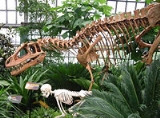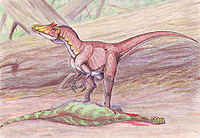
Deltadromeus
Encyclopedia
Deltadromeus is a genus
of large basal ceratosauria
n theropod dinosaur
from Northern Africa
. It had long, unusually slender hind limbs for its size, suggesting that it was a swift runner. The skull is not known. Two fossil specimens of a single species (D. agilis, or "agile delta runner") have been described, found in the Bahariya Formation
and Kem Kem Beds
, which date to the late Cretaceous
Period (mid Cenomanian
age), about 95 million years ago. It may be a junior synonym of the contemporary Bahariasaurus
.
 The fairly complete holotype
The fairly complete holotype
skeleton of Deltadromeus agilis (museum catalogue number SGM-Din2) measured an estimated 8 m (26.2 ft) long.
A second specimen (IPHG 1912 VIII) was originally described by Ernst Stromer
as a specimen of Bahariasaurus
, but was designated as a specimen of Deltadromeus by Paul Sereno
in 1996. This second specimen comes from a much larger individual, with a femur
(upper leg bone) length of 1.22 meters, compared to 0.74 meter femur of the holotype.
Deltadromeus skeletons have been found in the same formations as those of the giant theropods Carcharodontosaurus
, Spinosaurus
, and Bahariasaurus, which may be synonymous with Deltadromeus. No skull material has been found for either Deltadromeus or Bahariasaurus, and though carnivore teeth labelled as "Deltadromeus" are commonly sold in rock shops, there is no way of knowing if they actually come from this animal.
, though others have found it to be more primitive, possibly related to the primitive ceratosaurs Elaphrosaurus
and Limusaurus
.
Genus
In biology, a genus is a low-level taxonomic rank used in the biological classification of living and fossil organisms, which is an example of definition by genus and differentia...
of large basal ceratosauria
Ceratosauria
Ceratosaurs are members of a group of theropod dinosaurs defined as all theropods sharing a more recent common ancestry with Ceratosaurus than with birds. There is presently no universally agreed upon listing of species or diagnostic characters of Ceratosauria, though they were less derived...
n theropod dinosaur
Dinosaur
Dinosaurs are a diverse group of animals of the clade and superorder Dinosauria. They were the dominant terrestrial vertebrates for over 160 million years, from the late Triassic period until the end of the Cretaceous , when the Cretaceous–Paleogene extinction event led to the extinction of...
from Northern Africa
Africa
Africa is the world's second largest and second most populous continent, after Asia. At about 30.2 million km² including adjacent islands, it covers 6% of the Earth's total surface area and 20.4% of the total land area...
. It had long, unusually slender hind limbs for its size, suggesting that it was a swift runner. The skull is not known. Two fossil specimens of a single species (D. agilis, or "agile delta runner") have been described, found in the Bahariya Formation
Bahariya Formation
The Bahariya Formation is a fossil bearing geologic formation dating back to the Cenomanian, geographically located in Marsa Matruh, central Egypt.-Lepidosaurs:-Sauropods:Indeterminate sauropod remains.-Theropods:...
and Kem Kem Beds
Kem Kem Beds
The Kem Kem Beds is a geological formation in Morocco and Algeria whose strata date back to the Late Cretaceous...
, which date to the late Cretaceous
Cretaceous
The Cretaceous , derived from the Latin "creta" , usually abbreviated K for its German translation Kreide , is a geologic period and system from circa to million years ago. In the geologic timescale, the Cretaceous follows the Jurassic period and is followed by the Paleogene period of the...
Period (mid Cenomanian
Cenomanian
The Cenomanian is, in the ICS' geological timescale the oldest or earliest age of the Late Cretaceous epoch or the lowest stage of the Upper Cretaceous series. An age is a unit of geochronology: it is a unit of time; the stage is a unit in the stratigraphic column deposited during the corresponding...
age), about 95 million years ago. It may be a junior synonym of the contemporary Bahariasaurus
Bahariasaurus
Bahariasaurus is a genus of large theropod dinosaur found in the Bahariya Formation in El-Waha el-Bahariya or Bahariya oasis in Egypt and Kem Kem Beds of North Africa, which date to the late Cretaceous Period, , about 95 million years ago...
.
Description

Holotype
A holotype is a single physical example of an organism, known to have been used when the species was formally described. It is either the single such physical example or one of several such, but explicitly designated as the holotype...
skeleton of Deltadromeus agilis (museum catalogue number SGM-Din2) measured an estimated 8 m (26.2 ft) long.
A second specimen (IPHG 1912 VIII) was originally described by Ernst Stromer
Ernst Stromer
Ernst Freiherr Stromer von Reichenbach was a German paleontologist.He described the following Cretaceous dinosaurs from Egypt: Aegyptosaurus, Bahariasaurus, Carcharodontosaurus, and the largest known theropod, Spinosaurus aegyptiacus...
as a specimen of Bahariasaurus
Bahariasaurus
Bahariasaurus is a genus of large theropod dinosaur found in the Bahariya Formation in El-Waha el-Bahariya or Bahariya oasis in Egypt and Kem Kem Beds of North Africa, which date to the late Cretaceous Period, , about 95 million years ago...
, but was designated as a specimen of Deltadromeus by Paul Sereno
Paul Sereno
Paul Callistus Sereno is an American paleontologist from the University of Chicago who discovered several new dinosaur species on several continents. He has conducted excavations at sites as varied as Inner Mongolia, Argentina, Morocco, and Niger...
in 1996. This second specimen comes from a much larger individual, with a femur
Femur
The femur , or thigh bone, is the most proximal bone of the leg in tetrapod vertebrates capable of walking or jumping, such as most land mammals, birds, many reptiles such as lizards, and amphibians such as frogs. In vertebrates with four legs such as dogs and horses, the femur is found only in...
(upper leg bone) length of 1.22 meters, compared to 0.74 meter femur of the holotype.
Deltadromeus skeletons have been found in the same formations as those of the giant theropods Carcharodontosaurus
Carcharodontosaurus
Carcharodontosaurus was a gigantic carnivorous carcharodontosaurid dinosaur that lived around 100 to 93 million years ago, during the late Albian to early Cenomanian stages of the mid-Cretaceous Period...
, Spinosaurus
Spinosaurus
Spinosaurus is a genus of theropod dinosaur which lived in what is now North Africa, from the lower Albian to lower Cenomanian stages of the Cretaceous period, about 112 to 97 million years ago. This genus was first known from Egyptian remains discovered in 1912 and described by German...
, and Bahariasaurus, which may be synonymous with Deltadromeus. No skull material has been found for either Deltadromeus or Bahariasaurus, and though carnivore teeth labelled as "Deltadromeus" are commonly sold in rock shops, there is no way of knowing if they actually come from this animal.
Classification
Deltadromeus was originally described as a large coelurosaur, but more recent studies suggest it was actually a ceratosaur, though exactly what type of ceratosaur remains unknown. One 2003 study suggested it was a member of the NoasauridaeNoasauridae
Noasaurids were a group of theropod dinosaurs from the Cretaceous Period . They were generally small in size...
, though others have found it to be more primitive, possibly related to the primitive ceratosaurs Elaphrosaurus
Elaphrosaurus
Elaphrosaurus is a genus of theropod dinosaur from the Kimmeridgian stage of the Late Jurassic of Tanzania. Elaphrosaurus was probably a ceratosaur about 6 meters long. Suggestions that it is a late surviving coelophysoid have been entertained but are generally dismissed. It was first...
and Limusaurus
Limusaurus
Limusaurus is a genus of toothless herbivorous theropod dinosaur from the Jurassic Upper Shishugou Formation in the Junggar Basin of western China. Limusaurus is also the first definitely known ceratosaur from Eastern Asia, including China...
.

